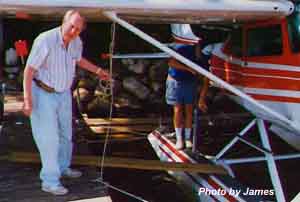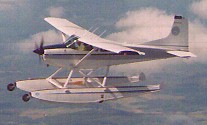SEAPLANES "It comes the closest to what we thought flying was going to be before we learned that it is filled with regulations, traffic patterns, radio navigation, etc., and a much greater reliance than we thought on other people in the aviation picture. It comes the closest to flying as it was in the barnstorming era". Minnesota has 10,000(+) lakes, seaplanes are not an uncommon sight in the land of lakes. Anders J. Christenson, FAA Pilot Examiner (GL-15-24) is a leading authority on seaplane pilot certification. With over 25,000 flight hours and 30 years as an examiner and instructor he has compiled observations collected over the years. For an individual consultation or dual flight instruction contact Anders at Flying Cloud Airport, Minneapolis, Minnesota USA (612) 944-4036 or email RudderFCM@aol.com OBSERVATIONS OF A SEAPLANE PILOT EXAMINER
|
|
Dedicated to the pilots who have had to dry their brows from perspiration and other reasons in their quest for the addition of "Airplane Single Engine Sea" rating on their Pilot's Certificate. |
|
Anders Christenson FAA Pilot Examiner GL 15-24 What's so tough about flying floats? That is one of the questions I might ask an applicant during the oral phase of their seaplane check ride. Over the years that I have been an examiner for seaplane ratings, I've asked myself that question from time to time. There are some cold facts that say that piloting a seaplane safely can be an exacting thing. What is it then that causes the risk to be so high in an otherwise most enjoyable flight experience of power pilots?
|
HOME BASE / PRIVATE PILOT / INSTRUMENTS / COMMERCIAL PILOT / MULTI-ENGINE / SEAPLANES / PROFICIENCY / TEST STANDARDS / WEATHER / BEYOND AVIATION / ADVANCED INFO

 I think a great
deal of the problem lies right there. It is so much fun. It comes the closest to what we
thought flying was going to be before we learned that it is filled with regulations,
traffic patterns, radio navigation, etc., and a much greater reliance than we thought on
other people in the aviation picture. It comes the closest to flying as it was in the
barnstorming era. It is just this feeling that causes otherwise excellent pilots to do
things in a floatplane that they would never think of doing in a land-plane. Let me cite a
very common example. A land plane pilot, when approaching for a landing at an airport,
will very likely circle the airport above pattern altitude, then enter a downwind leg at a
safe altitude, keep a safe altitude and have a reasonable distance on final approach. Put
this same pilot in a seaplane and he very commonly will disregard downwind altitudes and
final approach leg distances. I would like to see him use his imagination. I would
like to see him decide where he wishes to touch down on the water and then imagine a
75-foot wide runway beginning 300 feet before that point and extending for 2,000 feet
beyond it. I want him to imagine an airport right there on the lake - then treat it
like one - have the normal downwind, base and final legs. If we take all of our safety
procedures that have been so well trained into us and use them in our seaplane flying, we
will have a much better safety record.
I think a great
deal of the problem lies right there. It is so much fun. It comes the closest to what we
thought flying was going to be before we learned that it is filled with regulations,
traffic patterns, radio navigation, etc., and a much greater reliance than we thought on
other people in the aviation picture. It comes the closest to flying as it was in the
barnstorming era. It is just this feeling that causes otherwise excellent pilots to do
things in a floatplane that they would never think of doing in a land-plane. Let me cite a
very common example. A land plane pilot, when approaching for a landing at an airport,
will very likely circle the airport above pattern altitude, then enter a downwind leg at a
safe altitude, keep a safe altitude and have a reasonable distance on final approach. Put
this same pilot in a seaplane and he very commonly will disregard downwind altitudes and
final approach leg distances. I would like to see him use his imagination. I would
like to see him decide where he wishes to touch down on the water and then imagine a
75-foot wide runway beginning 300 feet before that point and extending for 2,000 feet
beyond it. I want him to imagine an airport right there on the lake - then treat it
like one - have the normal downwind, base and final legs. If we take all of our safety
procedures that have been so well trained into us and use them in our seaplane flying, we
will have a much better safety record.